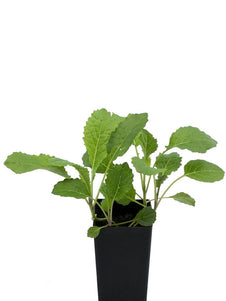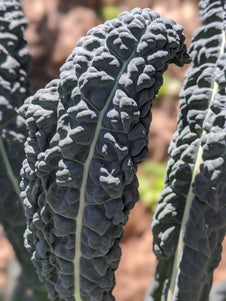





Kale - Tuscan Cavolo Nero Kale
Kale - Tuscan Cavolo Nero Kale

- Low stock - 6 items left
- Inventory on the way

Usually available: April to November
Life cycle: Annual
Height: 60 - 90cm
Position: Sun / part shade
Soil preference: Well drained
This is how we pack and send your Herb Plants to all states except TAS & WA
You will receive
- 1 Kale 'Tuscan Cavolo Nero' Herb Plant in a 50 X 75mm tube - General growing instructions
All of our Herb Plants are grown organically with certified organic potting mixes and fertilizers
Botanical Name: Brassica oleracea acephala
Kale 'Tuscan Cavolo Nero' is a large kale with long strappy leaves, with potential to reach 60-90 cm tall. It mayt have a wide spread as each leaf may grow to 2-4 inches wide, with 30cm high leaves on long greenish-white stalks. The leaves have a bumpy or embossed surface texture and are dark blue-green in colour. When the leaves are harvested, or cut away from the base, the plant takes on a fan or palm like appearance giving it a prehistoric presence.
Kale 'Tuscan Cavolo Nero' is reputed to be the best tasting kale and is prized by chefs in Italy. Until recently, this leafy green was one Tuscany’s best kept secrets. This is the kale used for the famous Tuscan soup known as Ribollita, or reboiled bean soup. It has been used in northern Italy for centuries, as an essential ingredient in dishes like risotto, pasta and frittata. The taste is slightly sweeter and more delicate than the curly kale varieties, but still retains an earthy component.
This kale is known by several common names including the popular ‘Cavalo Nero’, ‘Nero di Toscana’, the cultivar ‘Lacinato Kale’, Toscano Kale’, black cabbage, palm tree kale and dinosaur kale. It is a Borecole Heritage Variety, having been introduced pre- 1879.
Kale General
Kale is a leafy vegetable with a long history as a staple food source, although its reputation suffered in modern times. Kale was a staple and common food in Europe until the end of the Middle Ages and was used in the Mediterranean as early as 2000 BC. History shows that curly leafed vegetables, precursors to kale, were used by the end of the 4th century BC. Kale was also promoted during WWII for its nutritional value and because rationing resulted in the absence of other foods. However, it lost favour and has made a recent return due to renewed focus on ‘super foods’. Although there are other foods with higher nutritional value, kale has up to 6 times more calcium than broccoli, high levels of antioxidants and high vitamin A, C and K content. It is worthy of its growing reputation with proponents of healthy eating. Kale has also regained popularity as a result of being showcased in many cooking programmes on television.
Kale belongs to the Brassicaceae family and the Brassica genus, which also includes cabbage, cauliflower, broccoli, brussel sprouts, and collard greens. Kale is the most primitive and closer to wild forms of cabbage than other members of this genus. The botanical name for kale is Brassica oleracea var acephala, which translates to ‘cabbage of the vegetable garden without a head.’ Cabbage is named B. oleracea var capitata or ‘with a head’. The ‘acephala’ cultivar includes the non-heading greens. The word ‘kale’ has several origins, all from words referring to the cabbage group of plants and acknowledging the ‘head shape’. The Scottish word ‘coles’, the German word ‘kohl’ and the Roman ‘cauls’ all refer to kale. The word ‘borecole’ or ‘boerenkool’ is also used quite commonly and translates to ‘farmer’s cabbage’. It has its origins in the Dutch word ‘boer’ or farmer/peasant and ‘kool’ or ‘cole’ meaning cabbage.
Kale has many varieties and cultivars that have an extensive palette of colours ranging from pale yellow to deep green, from deep steel blue to purplish red tones and even to an almost black leaf. Despite this colour range, kale is usually classified by its texture and leaf form which also provide great variety and ornamental value. Kale may be curly, plain, rape leaf, leaf and spear kale, or Cavalo Nero which is distinctive in its own right. Sometimes these categories are identified as Russian Kales which have almost flat leaves with finely divided edges, Scotch Kales have wrinkled leaves and Tuscan or Cavalo Kale is long and strappy. Alternatively they may be called curly, red or black kale and some varieties have numerous cultivars with slightly different characteristics. If you are seeking a specific kale for your garden it could be best to check the cultivar and botanical name.
Some Kales are also grown for their ornamental value, so this gives even the many unpalatable kales a place in the garden. When used for food, the plants become less clumpy and more fan or palm tree shaped, as the lower leaves are removed. The more common kales range in size from 30-90cm. Some have bolder colours, while others may reach 180cm but although ornamental, they are generally unpalatable.
Growing Conditions
Kale is a hardy vegetable green that will grow under most conditions, including part shade which is useful in the heat of summer. Enriched soil is desirable but most soils are acceptable, as long as they are well drained. Slightly alkaline soil will be tolerated. Full sun will generate the best results, because kale tastes better when grown quickly. This can be helped by regular watering, adding fertilizer and having rich soils. Kale may survive drought or irregular watering but the leaves are likely to end up tasting bitter. Kale is one of the larger growing vegetables, so a good space allocation is required.
Kale has a very wide range of suitable climate zones, with the main consideration being that the leaves must mature during the cool weather. This means that the timing of planting will vary a little because kale does not tolerate hot weather once it is growing. Kale is not a tropical region vegetable, but it does tolerate frost and snow very well. Due to its cold tolerance, kale will germinate from 5C up and up to 35 C. Seeds may be planted when the weather is warm to enable growth to occur in the cooler period. Kale is usually grown annually from seed planted in spring or autumn, although it is classified as a hardy biennial and may produce for two years.
The flavour of kale is sweetened when it is grown through a period of frost or even a cold snap. It even survives under snow, enabling the northern hemisphere to have kale in cold winters. After a cold snap the leaves will curl or wrinkle, become textured and strengthen their form. When cold weather is approaching kale will benefit from mulching to offer some root protection. If you are in a particularly cold area, the blue-green forms may have an association with increased cold tolerance. The leaves should be mature after 53-65 days, or picked as baby leaves after 6-7 weeks.
Kale is said to be good companions to beet, celery, lettuce, onion, potatoes, cucumber, dill, garlic, hyssop, mint, nasturtium, rosemary, sage, Swiss chard and spinach.
Culinary Uses
Kale is a versatile vegetable that can be used raw in salads, stir fried, sautéed or included in stews and almost any dish.
When baked, or dehydrated, kale takes on the consistency of potato chips and baked kale drizzled with olive oil has become a popular healthy snack. Overcooking kale will result in a bitter taste. It is also a good idea to remember to remove the large, thick stems and use only the leafy portion.
Kale goes well with strong ingredients such as nuts and capsicum, which helps to intensifies the flavour, while combining it with oils and lemon decreases the intensity. The young or baby leaves can be picked after 6-7 weeks and used fresh. Kale also freezes well, so it is possible to prepare kale and freeze for later use.
All information provided on this website is for informational purposes only. Please seek professional advice before commencing any treatment.





